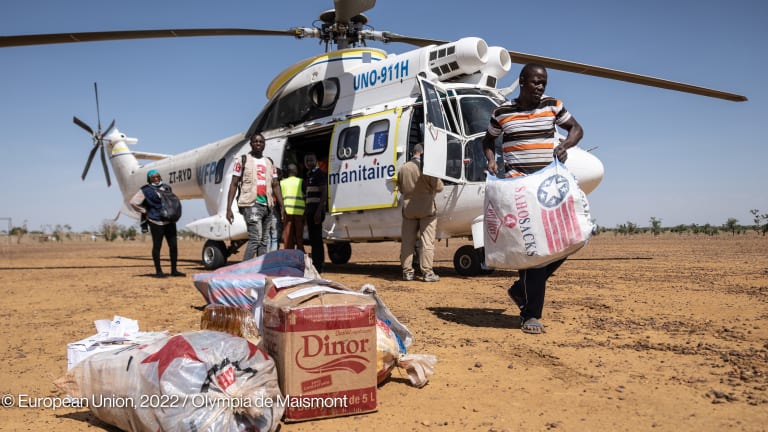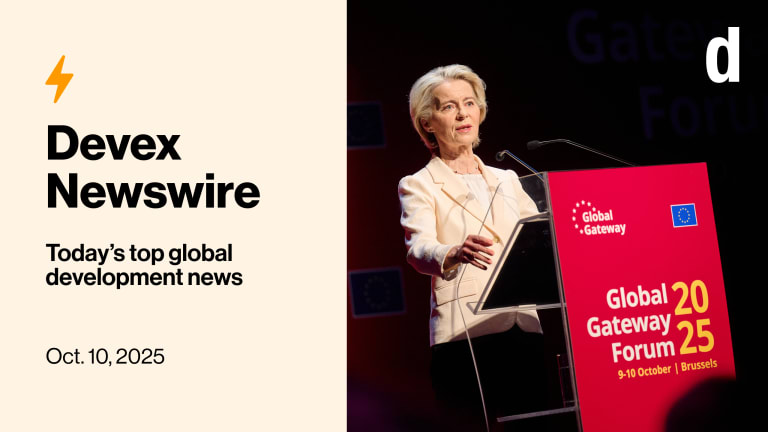
BRUSSELS — In the absence of commercial air travel, the European Commission has allocated €10 million ($11 million) to fly humanitarian staff and supplies on up to 30 routes deemed important for the COVID-19 response.
The first Humanitarian Air Bridge flight took off last week from Lyon, France, to Bangui, Central African Republic. Some 60 humanitarian workers from various NGOs and 13 metric tons of humanitarian cargo were on board the aircraft, which returned with EU citizens and other people from CAR as part of a repatriation effort.
Should aid workers travel during the pandemic?
Many groups are advocating for humanitarian exemptions to travel restrictions to save lives.
Also aboard was Janez Lenarčič, the European Union crisis management commissioner, though he and his staff did not leave the airport building in Bangui, where they met CAR President Faustin-Archange Touadéra.
That meeting alone made it “worth the trip” Lenarčič told Devex by phone from the Lyon airport prior to his departure Thursday evening, adding that he had judged it important to travel in person to signal EU solidarity extending beyond its borders.
Lenarčič said he also wanted to show the need for countries to allow the transport of humanitarian goods and personnel. When travel restrictions due to COVID-19 went into effect, humanitarian exemptions were often lacking, Lenarčič said, though “CAR has such an exemption, and that’s also one of the reasons why this first flight goes there.”
The Slovenian said the EU air bridge — which will focus on the most pressing humanitarian bottlenecks, especially in Africa — is designed to act as a temporary measure “to fill the gaps” before a similar logistical effort by the United Nations is running at full capacity.
“It is good that the EU and Lenarčič show some leadership on humanitarian issues,” said Pauline Veron, junior policy officer at the European Centre for Development Policy Management, a think tank.
“The EU has been very public about the repatriation of its citizens, but it will have to significantly scale up its humanitarian response given the scope of the needs, and this is much less easy to sell politically in the current context,” Veron said.
European solidarity frayed early in the coronavirus crisis, as different countries sought to keep scarce protective medical equipment for themselves. The commissioner, who is responsible for emergency response both at home and abroad, said a key lesson of COVID-19 is that the bloc’s own Civil Protection Mechanism — which EU countries activate when they need assistance from other member states — was not adapted to a situation in which every country is affected.
“That’s why we proposed ... to form a strategic reserve capacity at the EU level for medical equipment,” Lenarčič said, “so that if there is a second wave or another outbreak, we will have a reserve capacity also at European level, so as to make sure that even if everyone is affected, there will still be some stock that would be available for those who need it most.”
“The EU has been very public about the repatriation of its citizens, but it will have to significantly scale up its humanitarian response given the scope of the needs.”
— Pauline Veron, junior policy officer, European Centre for Development Policy ManagementHe said that €370 million was foreseen for such stockpiling from this year’s budget but that the plan’s long-term funding would depend on the EU’s 2021-27 budget, which is still under negotiation.
Veron from ECDPM said such a stockpile could be useful but stressed that “access should be on the basis of need, regardless whether it is Europeans or non-Europeans who need it.”
A commission official told Devex that material from the strategic reserve, known as rescEU, could be available to countries outside the bloc, provided that the disaster could “significantly affect one or more member states or their citizens.” The commission is “looking into ways to strengthen the international dimension of this mechanism,” the official added.
Visit our dedicated COVID-19 page for news, job opportunities, and funding insights.









